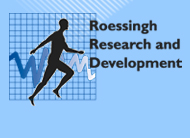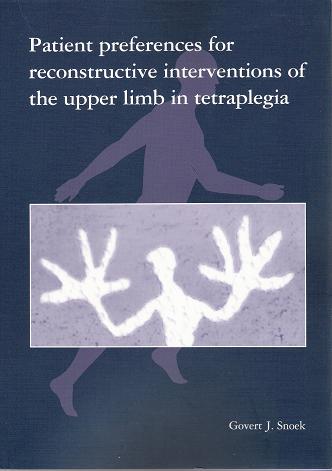Patient preferences for reconstructive interventions
of the upper limb in tetraplegia

 Govert Snoek, MD (Researcher)
Govert Snoek, MD (Researcher)
Maarten IJzerman, PhD (Project leader)
Anand Nene, MD,PhD (Project leader)
Marcel Post, PhD
On December 8, 2005, Govert Snoek, defended his dissertation entitled:
Patient preferences for reconstructive interventions of
the upper limb in tetraplegia
Summary
A number of studies have reported on the relationship between the level of Spinal Cord Injury (SCI) and the degree of self-care and mobility. Rehabilitation therapy aims at achieving optimal independence within the constraints of neurological deficit. In this respect, adequate therapy of the upper extremities in individuals with tetraplegia is very important. Therapy of the upper extremities can be sub-divided into 3 phases: the acute phase, the subacute phase, and the reconstructive phase. Reconstructive surgery or, more recently, the application of neuroprostheses, can be considered in certain selected cases during the third phase. The aim of these procedures is to improve upper extremity function and, more importantly, upper extremity skills. The results of these procedures have been reported in a number of studies. In general, the results are good and the patients who have undergone these procedures are satisfied with the results. Various studies indicate that approximately 60% of the population with tetraplegia could benefit from reconstructive surgery, and that approximately 10% of this population might be suitable candidates for functional electrical stimulation (FES) implants. However, clinical practice has shown that suitable patients for reconstructive upper extremity procedures often decide not to undergo these procedures. In this respect it is relevant to know how important improvement of upper extremity function is for individuals with tetraplegia and what factors influence the decision to undergo reconstructive procedures. These questions are the focus of the present thesis.
Chapter 2 describes a study that was carried out to investigate the impact of upper extremity deficit in subjects with tetraplegia, compared to the impact of other impairments. A survey was sent to all the members of the Dutch and UK Spinal Cord Injury (SCI) Associations. They were asked to indicate on a 5-point scale the improvement in quality of life (QOL) they expected to achieve from improvement in hand function and 7 other SCI-related impairments. The overall response was 42%; 426 of the 700 Dutch questionnaires (61 %) and 1122 of the 4800 UK questionnaires (23%) were returned. A total of 565 subjects had a tetraplegia and it is arguable that the tetraplegic sample covers the spectrum of cervical SCI. The results in the Dutch and the UK groups were comparable. Overall, 77% of the subjects with tetraplegia expected an important or very important improvement in QOL if their hand function improved. This is comparable to their expectations with regard to improvement in bladder and bowel function. All other items were scored lower. This study is the first in which the impact of impairment in hand function has been assessed in a large sample of tetraplegic subjects and relatively compared to other SCI-related impairments. The results indicate a high impact and a high priority for improvement in hand function in tetraplegics, comparable to that for bladder and bowel dysfunction, which is known to have great impact on the lives of SCI patients.
The objective of the study described in Chapter 3 was to explore possible functional effects of the Handmaster-FES system in subjects with tetraplegia. The Handmaster is a non-invasive FES system, and can be regarded as a third-phase treatment option with relatively less intense treatment characteristics than other more invasive treatment options in this phase. Ten patients with cervical spinal cord injury between C4 and C6, motor group 0-3, were consecutively selected trom the inpatient and outpatient department of the Roessingh Rehabilitation Centre. Each patient was fitted with a Handmaster by a qualified therapist, and underwent muscle strength and functional training for at least two months. Functional evaluation was based on the performance of a predefined set of tasks and at least one additional task selected by the patients themselves. The tasks were performed both with and without the Handmaster. Finally, the patients were asked to give their opinion on actual use of the Handmaster as well as their willingness with regard to future use. Six patients were able to grasp and release with Handmaster stimulation. Four patients could perform the set of tasks with the Handmaster, but were not able to do so without the Handmaster. Upper extremity function improved in three patients after the training period. One patient continued using the Handmaster during ADL at home, and this patient was the only one who succeeded in performing all the tasks he selected with the Handmaster Based on our clinical experiences, we concluded that the Handmaster could be of functional benefit for a limited group of patients with a C5 level spinal cord injury, motor group 0 and 1. Suitable patients should have sufficient shoulder and biceps function, combined with absent or weak wrist extensors. Furthermore, the Handmaster should improve skills which are important for the patient. This case series showed that the therapeutic use of the Handmaster can also be considered in subjects with tetraplegia.
In the study described in Chapter 2, a non choice-based method was used to estimate the importance of improvement in various impairments. The advantage of such a method is that it is relatively easy to apply. However, there are some theoretical drawbacks. If a method to assess preference involves no actual choice, no trade-off can be observed, and no exact comparison can be made between the preferences assessed in this way. Therefore, further and more precise research was carried out. In the study described in Chapter 4 a choice-based preference elicitation method, the Time Trade Off (TTO) method, was used to determine the quality weight of five tetraplegic health states, and expressed as a single value (the "utility") on a scale between 0 (worst possible situation) and 1 (best possible situation). A second objective was to evaluate the effect of patient characteristics as well as functional status on the utility of the tetraplegic health state without upper extremity impairments. A consecutive sample of 47 individuals with tetraplegia in a stable condition, recruited in the outpatient department of two specialised Spinal Cord Injury Centres in the Netherlands, was assessed. The utility of tetraplegia was 0.57 (SD 0.30). The utilities of tetraplegia without impairment in one of the following functions were: sexuality 0.69 (SD 0.33), standing/walking 0.69 (SD 0.33), bladder and bowel function 0.63 (SD 0.31), and upper extremity function 0.65 (SD 0.32). The differences between these utilities and the utility of tetraplegia were significant (p< 0.05). No significant differences were found between the utilities of the impairments. Improvement of a specific impairment contributed between 14% and 28% to the potential overall gain in the utility of the tetraplegic health state. The results of multivariate regression analysis did not indicate a significant set of determinants for the utility of tetraplegia without impaired upper extremity function. We concluded that, in general, in subjects with long-lasting SCI a combination of impairments is responsible for the low utility of the tetraplegic heath state. Improvement in major impairments results in a significant improvement in the utility of the tetraplegic health state. However, no differences were found between the utility of the tetraplegic health state without impaired upper extremity function and the utility of the tetraplegic health state without three other major impairments respectively. The TTO method enabled the explanation of the discrepancy between the number of patients who are suitable for surgical treatment, their self-reported importance of improved upper extremity function, and the low number of patients who proceed to surgical treatment in a broad sample of individuals with tetraplegia.
Based on the results of the TTO study, it can be argued that there is no single most important impairment to be treated in tetraplegia, and the decision to treat impairments is based on individual considerations. The decision to undergo treatment is based on a variety of criteria, and multi-criteria decision analysis techniques can be used to study the effect of the various criteria on the decision. The aim of the study described in Chapter 5 was to assess the effect of non-health outcome factors in relation to the effectiveness of the intervention on the decisions of subjects with tetraplegia concerning reconstructive UE interventions. In a sample of 49 individuals with tetraplegia in a stable condition, recruited in the outpatient departments of seven specialised Spinal Cord Centres in the Netherlands, the importance and the relative weight of 7 treatment characteristics on the decision to undergo reconstructive surgery was determined by means of Conjoint Analysis (CA). All 7 characteristics contributed to the decision to undergo surgery (p< 0.01). The relative weights were: for type of intervention 0.14 (95% confidence interval [CI] 0.05-0.23), for number of operations 0.15 (95% CI: 0.05-0.25), for inpatient rehabilitation period 0.22 (95% CI: 0.10-0.32), for outpatient rehabilitation period 0.08 (95% CI: 0.02-0.14), for risk of complications 0.16 (95% CI:0.06-0.26), for results of elbow function 0.1 (95% CI:0.020.18), and for results of hand function 0.15 (95% CI: 0.05-0.25). In 40.8% of the subjects one characteristic had a relative weight of 0.30 or more. We concluded that the study demonstrates the applicability of CA in rehabilitation and spinal cord injury research to study the effect of health outcome and non-health outcome factors on the decision to undergo therapy. With regard to reconstructive UE interventions, in subjects with tetraplegia non-health outcome factors indicating the intensity or burden of the treatment are as important or even more important than outcome with regard to hand or elbow function in their decisions concerning therapy. The inpatient rehabilitation period was the most important factor. The fact that over 40% of the subjects focused on only one treatment characteristic in deciding about therapy is important knowledge for clinicians when informing patients about therapy.
With regard to upper extremity interventions, patients are advised and treated by multidisciplinary teams. Although these teams have to work closely together, and are very co-ordinated, the members of the team each have their own experience, knowledge and opinion about the application of therapy. This not only has an implicit effect on the opinions and advice of the team as a whole, but also on the individual advice that team members give to their patients. It is important to be aware of this situation and in complex therapies both team opinions and individual opinions about the application of therapy should be made explicit. In the study described in Chapter 6, another multi-criteria decision method, the Analytic Hierarchy Process (AHP), is used to support the evaluation of the importance of treatment characteristics of reconstructive interventions of the upper extremities (UE) by a rehabilitation team and a group of subjects with a C6 level tetraplegia. Furthermore, the performance of two different treatment approaches (conventional upper extremity reconstructive surgery and reconstructive surgery combined with FES) for the upper extremity in a patient with a C6 motor group 2 tetraplegia were evaluated by the rehabilitation team. The main treatment requirements with their relative importance, as determined by the rehabilitation team and the patients (rehab. team/patients), were: functional improvement (.54/.39), treatment load (.03/.11), risks (.26/.21), userfriendliness (.17/.25) and social outcomes (.05/.04). The differences between the ratings of the rehabilitation team and the patients were significant for improvement of the arm-hand function (p = 0.005) and the treatment load (p = 0.01). In evaluating both treatment options, functional improvement after FES was considered to be better than conventional surgery. Yet, the overall rating of the rehabilitation team for conventional surgery was slightly higher than for FES (56% versus 44%), based on the better performance of conventional surgery with regard to the other treatment requirements. We concluded that this study demonstrates that the evaluation of new technology has to be more comprehensive than evaluation of functional improvement alone. Furthermore, it demonstrates that the preferences of patients may differ from the preferences of the rehabilitation team.
In Chapter 7 the most important findings of our research are discussed with regard to the implications for treatment of the VE in tetraplegia, the organisation of SCI services and future research on treatment of the UE in tetraplegia. Also discussed is the use of choice-based and multi-criteria decision methods to assess rehabilitation technology.
Publications
-
Survey of the needs of patients with spinal cord injury: impact and priority for improvement in hand function in tetraplegics. Snoek GJ, IJzerman MJ, Hermens HJ, Maxwell D, Biering-Sorensen F. Spinal Cord, 42(9): 526-32, 2004.
-
Use of the Ness-HandmasterTM to restore hand function in tetraplegia: clinical experiences in 10 patients. Snoek GJ, IJzerman MJ, In 't Groen, FACG, Stoffers TS, Zilvold G. Spinal Cord, 38: 244-49, 2000.
-
Choice-based preference for improving hand function compared to other impairments in tetraplegia. Snoek GJ, IJzerman MJ, Post MWM, Stiggelbout AM, Roach MJ, Zilvold G. Arch Phys Med Rehab, 86: 1623-1630, 2006.
-
Decision for reconstructive interventions of the upper extremities in tetraplegia: the effect of treatment characteristics. Snoek GJ, van Til JA, Krabbe PFM, IJzerman MJ. Spinal Cord 46(3):228-33, 2008.
-
A multicriteria decision analysis of augmentive treatment of upper extremities in persons with tetraplegia. Hummel MJ, Snoek GJ, van Til JA, van Rossum W, IJzerman MJ. JRRD, 42(5), 635-44, 2005.
|
|
|
 |